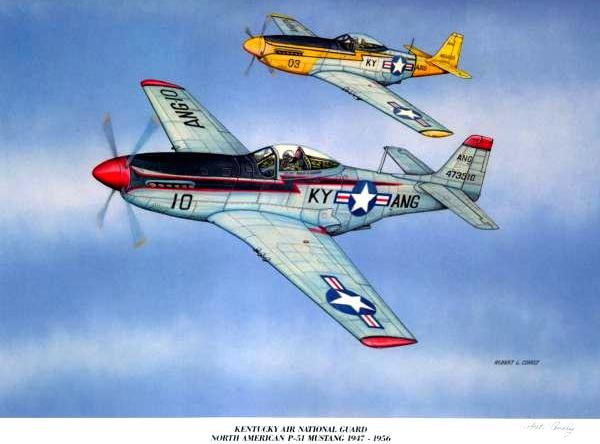
Kentucky Air National Guard North American P-51 Mustang 1947-1956 by Robert L. Conely For more information about the paintings or prints you can contact the artist at bobandlois2@yahoo.com North American - F-51 Mustang - 1947 – 1956 - In May 1947, 25 F-51 Mustangs arrived at Standiford Field and would be flown by the 123d Fighter Group and 165th Fighter Squadron. In 1950, the 165th earned national attention when it was awarded the coveted Spaatz Trophy during a competition between wing flying squadrons. The unit’s combat readiness and flying proficiency were reasons why President Harry S. Truman recalled the unit to federal service in 1950 to support the United States war effort in Korea.
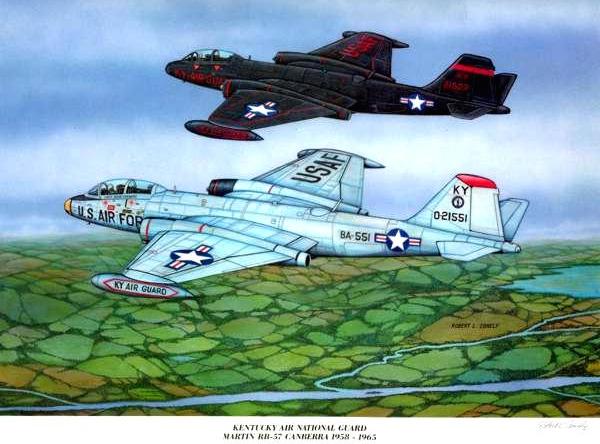
Kentucky Air National Guard Martin RB-57 Canberra 1958-1965 by Robert L. Conely. For more information about the paintings or prints you can contact the artist at bobandlois2@yahoo.com Martin - RB-57 Canberra - 1958-1965 - The Canberra brought an entirely new mission to the Kentucky Air National Guard, aerial photographic reconnaissance. The unit was redesignated the 123d Tactical Reconnaissance Wing / 165th Reconnaissance Squadron. The Canberra was capable of taking detailed photographs at high and low altitudes and saw action in military exercises Operation Willow Freeze, Alaska 1960 and 1961, and Operation Swift Strike, South Carolina 1961. The soaring Canberras had a most forgiving nature that would permit mistakes without serious consequences. It was to lead to about seven years without serious accident and without any fatalities in the aircrews. The Canberra era closed with the unit being recognized by the National Guard Bureau as the best Air National Guard Unit in the nation for 1965 and with that honor the prestigious Spaatz Trophy.
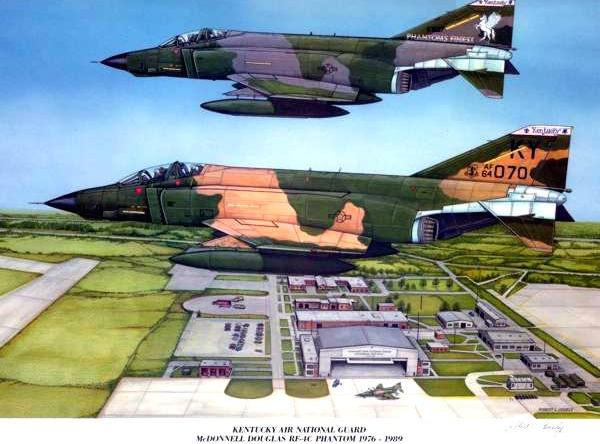
Kentucky Air National Guard McDonnell Douglas RF-4C Phantom 1976-1989 by Robert L. Conely For more information about the paintings or prints you can contact the artist at bobandlois2@yahoo.com McDonnell Douglas - RF-4C Phantom - 1976 – 1989 - The two-crew Phantom supplied the Kentucky Air National Guard with a state of the art reconnaissance fighter that had the ability to perform at night and all weather at speeds exceeding mach two. The unit participated in several European deployments: Coronet Snipe in Norway 1978, Coronet Bishop at Ingolstadt Air Base, West Germany 1983, and Coronet Shoshoni at Zweibrucken Air Base, West Germany in 1986. The Kentuckians also represented the Air National Guard in the NATO photo competition “Best Focus ‘82” in Denmark. During the Phantom era the Kentucky Air National Guard won the Air Force Outstanding Unit Award an unprecedented six times, the prestigious Spaatz Trophy in 1981, and Distinguished Flying Plaque in 1980, 1983, and 1987.
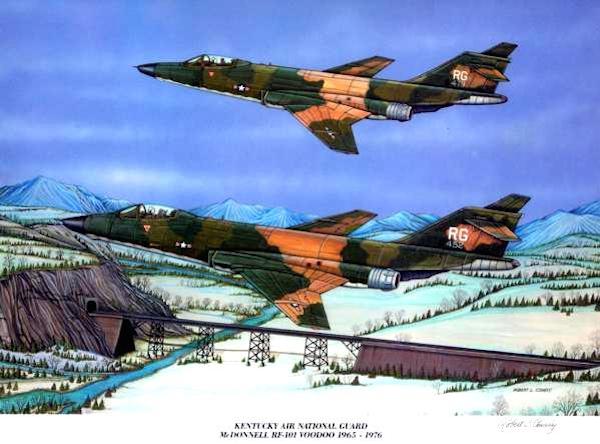
Kentucky Air National Guard McDonnell RF-101 Voodoo 1965-1976 by Robert L. Conely For more information about the paintings or prints you can contact the artist at bobandlois2@yahoo.com McDonnell - RF-101 Voodoo - 1965-1976 - The mighty Voodoo provided the Kentucky Air National Guard with its first supersonic aircraft and a jet capable o of air to air refueling. With military forces heavily engaged in Vietnam in 1968, President Lyndon B. Johnson recalled the 123d Tactical Reconnaissance Wing to federal service on January 26 in response to North Korea’s capture of an intelligence ship, the U.S.S. Pueblo. Known as the Pueblo Recall, the wing was ordered to Richards-Gebaur AFT, Missouri, near Kansas City. To bolster forces in Korea, the Kentuckians deployed to Itazuke Air Base, Japan from April – January 1969 and participated in Exercise “Focus Retina” where their pre-strike photography was used in the largest air assault in Korea in history. The wing was deactivated and returned to state control in June 1969. The Air Force Outstanding Unit Award was presented to the wing for its extraordinary achievement.
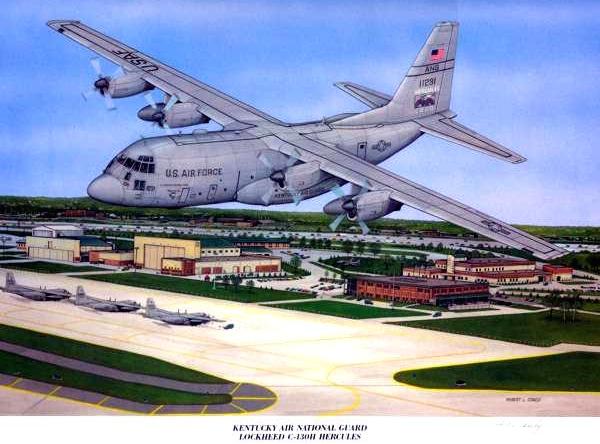
Kentucky Air National Guard Lockheed C-130H Hercules by Robert L. Conely For more information about the paintings or prints you can contact the artist at bobandlois2@yahoo.com Lockheed - C-130 Hercules - 1989 – Present - Airlift became the primary mission of the Kentucky Air National Guard with the arrival of the C-130B Hercules. The large, four-engine turbo-prop resulted in the unit being redesigned on two occasions and today is known as the 123d Airlift Wing / 165th Airlift Squadron. Although not federally mobilized, unit volunteers airlifted more cargo than any other Air National Guard unit during Desert Shield / Desert Storm. In 1992, 12 C-130H models arrived in Louisville including the 2000th C-130 built by the Lockheed Corporation. The unit placed itself at the forefront of world and national attention with humanitarian relief missions to Somalia, Bosnia-Herzegovina, and Rwanda in 1993-94. The unit returned to Bosnia-Herzegovina to support peacekeeping missions in 1996. The Kentucky Air National Guard won the Air Force Outstanding Unit Award – its eighth and ninth awards, a Distinguished Flying Plaque in 1993, and the 1994 Metcalf Trophy.
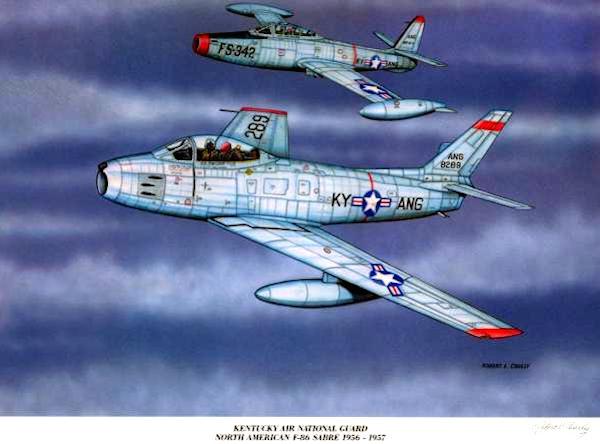
Kentucky Air National Guard North American F-86 Sabre 1956-1957 by Robert L. Conely For more information about the paintings or prints you can contact the artist at bobandlois2@yahoo.com North American - F-86A Sabre - 1956-1957 - On September 13, 1956 the first of 25 North American F-86A Sabre Jets arrived in Louisville. Preceding this, the Kentucky Air National Guard was redesignated the 123d Fighter Interceptor Wing / 165th Fighter Interception Squadron. Sabres were used to supplement the air defense of a 300 mile sector around Louisville. Four pilots were placed on alert during daylight hours to be airborne within three minutes of a scramble. Republic - F-84 Thunderjet - 1951-1952 -- In 1950 President Harry S. Truman recalled the 123d Fighter Group and 165th Fighter Squadron to federal service to support the United States war effort in Korea. 123d and 165th pilots were trained as replacement pilots in the F-84 Thunderjet. The majority of pilots were ordered to Manston RAF, England to bolster NATO forces in Europe. A few pilots saw combat action with other units including Captain John William Shewmaker who was killed while flying an escort mission over North Korea in 1951, and for whom the base on Grade Lane was named in 1960.